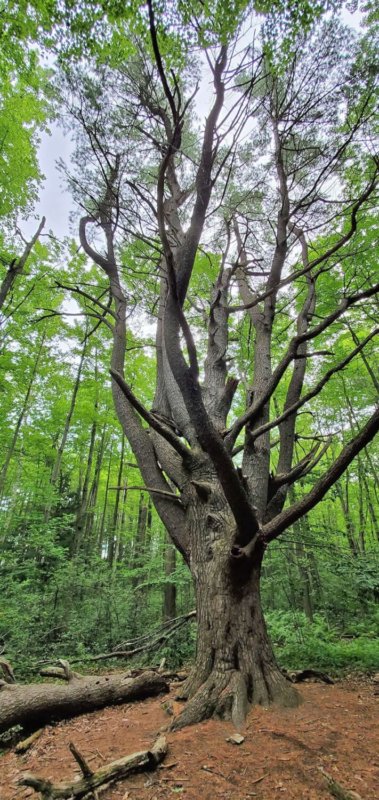White Pine: A History

Eastern white pine (Pinus strobus) is perhaps New England’s most celebrated tree. It graces Vermont’s state seal and is the state tree of Maine (its cone is Maine’s state “flower”) and Michigan. It’s notoriety dates back to the 1600’s, when European explorers wrote excitedly of North America’s massive pine, reputed to be hundreds of feet tall and broad enough to turn a team of oxen around on their stump. Today, the white pines growing in our forests are very different, but it remains an important tree species with a fascinating history.
Upon arriving in the “New World” from timber-starved Europe, Europeans were awed by the size and quantity of timber here. Particularly prized were the enormous pine, which were large enough to be ships’ masts for the British navy. At a time when naval dominance was incredibly important, trees large enough to be masts were an extremely significant resource for European powers. White pine lumber was also a prized building material, and so the early exploitation of New England’s forests focused almost solely on the species. They were so important that in the early 1700’s King George I declared all pine trees greater than 24” in diameter to be property of the crown. Surveyors designated these trees with the “King’s Broad Arrow,” a mark of three axe cuts in an arrow or “turkey foot” design. Colonists were forbidden to cut these trees, which is said to have been one of the grievances that incited the American Revolution.
Today, according to the US Forest Service, Eastern white pine is Vermont’s fourth most prominent tree species. However, land use has created white pines very different from those historic “mast pines.” In the 1800’s about 80% of Vermont was deforested, primarily for pasture. Much of this pastureland was abandoned, and allowed to revert to forest, in the late 1800’s-early 1900’s. In these regenerating fields, white pine found an unusual niche. The reasons for this are not entirely clear: some say that their seeds penetrate sod better than others, or that livestock browsed and/or meadow voles girded other tree species, but neither animal found white pine palatable. Whatever the reason, most white pine we have today is growing on the site of old pastures, rather than on sites where it may have been found prior to the 1800’s.
Two main pests afflict white pines today. The white pine weevil is a native insect that lays eggs in the terminal bud (“leader”) of young white pines. It generally attacks pines growing in full sunlight, so those growing in old fields were a perfect target. When the weevil larvae hatch they kill the leader, prompting multiple lateral buds to form secondary leaders. The result is “cabbage pines,” trees with many crooked stems like the 14-stem pine depicted on Vermont’s state seal. The vast majority of the white pine trees I see are damaged by the white pine weevil.
Another pest of note is “blister rust,” (Cronartium ribicola), a fungus first discovered in the region in 1909. Blister rust requires both white pine and plants in the genus Ribes (currants and gooseberries) to complete its life cycle, and so in the early 1900’s the cultivation or possession of Ribes plants became federally regulated, a ban that was lifted in 1966. In the early-mid 1900’s, crews were dispatched to eradicate Ribes plants, walking through public and private land and killing all they found. This started with the Civilian Conservation Corps (CCC) in the 1930’s and continued in one form or another through the 1960’s. After the federal ban on Ribes was lifted, some New England states legalized the species, although in Maine and several other states it remains illegal. Even through the 1980’s, growers of currants in Vermont were required to certify that they were 900 feet from stands of healthy white pine.
As our forests recover from the land clearing of the 1800’s, they may come to more closely resemble pre-settlement forests, and many areas where white pine currently thrives will likely shift towards a mix of other tree species. White pine will probably remain in our forests as a scattered tree, towering over its neighbors, and on sites where soils are deep and well-drained. Maybe, with some good management, we will again grow healthy white pine trees that awe us like they awed Europeans four centuries ago.
Ethan Tapper is the Chittenden County Forester. He can be reached via email, by phone at (802) 585-9099 or at his office at 111 West Street, Essex Junction.

